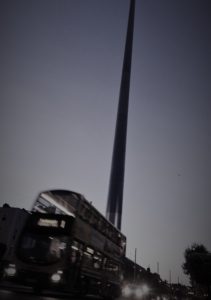Everybody rides the bus here. Now, I don’t mean to take anything away from the snobs who ride commuter rail, nor from anyone who inexplicably rides the Luas. I’m sure even those odd folks step aboard a blue and yellow Dublin Bus from time to time. The important thing to note is that, if you come to Dublin to visit or to serve in the community or just to sit in a pub and drink, you’ll want to know how to do this. I’ve broken this down into five easy steps.
1. Find your route.
You should know right off the bat that the bus map is set up like a wheel with spokes, meaning pretty much all routes lead to and from the city centre. As such, if you live in an outlying area, you’ll probably have very few buses that come near you. This makes it easy. On the other hand, if you’re in the city centre, you’ll watch every single bus go by. Choose carefully.
Finding the right bus is simple. They all have unique numbers. Furthermore, the numbers are all closely related. To get from the city centre to my area you can take the 25, 25A, 25B, 25D, 25X. Or 67. Oh, and don’t worry about all those letters after the numbers. They absolutely will take you different places, and you absolutely will wind up in the wrong place if you’re not paying attention.
2. Get on the bus.
Once you’ve found the right bus (and where that bus will collect you), go to that bus stop. But don’t let the name fool you! Even though “bus” and “stop” are both in there, the bus will definitely not stop unless you signal it properly. And really, why would it? Just because you’re standing right next to one of those yellow circular signs, the driver respects your privacy and will not simply assume you want to ride the bus. What’s the signal? You put your hand straight out. Or maybe you raise it like it in a classroom. Some people point at the ground. I’d love to be able to tell you that you can just make any gesture, but there are signals that tell the driver you’re not signaling him but the bus right behind. There may even be signals that tell the driver where your family lives in the West of Ireland.
The bus will stop directly in front of the bus stop, plus or minus maybe a hundred meters. Since you never know exactly where it will come to rest, you and all the other riders waiting to board should spread out along the curb. The driver will select the rider who is most worthy and stop with the door right in front of them. It was me once.
I should say something about the fares here as well. Unless you have a degree in mathematics and geography, there is little chance you’ll be able to calculate your fare. Drivers, on the other hand, know instinctively. Whether it’s €0.90 or €3.30, just make sure you give the exact amount. Not only are the drivers not able to make change, they will judge you if you pay too much.
3. Sit down.
This sounds obvious, but even sitting down is tricky. The first few rows are reserved for the disabled, the elderly, and I suppose the apathetic. If there are no empty seats, you may have to sit next to someone. Pay special attention to those who don’t want you to sit with them. They will avoid eye contact and take up 60-65% of the seat. Move along. If every seat has two people in it, you have to stand. Pay no attention to the signs that list out “maximum occupancy” on the bus. During peak commute times, these numbers can behave like a calculus equation and approach infinity. Even in the close and awkward quarters during these times, it’s still generally not okay to talk on the bus.
4. Alight at the proper stop.
This sounds easy. But why would it be easy to find your way when you’re on the bus? It’s not easy to find your way when you’re not on the bus. Google will call your stop one name. The Dublin Bus app will call it something else. The announcement on the bus loudspeakers will call it something else. And the screen will often say something completely different! Any given route may have multiple stops that have exactly the same name on both the screen and the loudspeaker (ours literally goes “Ballyowen Road”, then “Ballyowen Lane”, and then “Ballyowen Road”). The driver will not let you off except at an official bus stop. So good luck with that.
5. Start walking.
It seems superfluous to say you’ll walk a lot when you take the bus, since you’ll walk a lot whether you take the bus or not. To my American readers, when you say something is within “walking distance”, what do you mean? Whatever you have in mind, understand it is significantly longer in Dublin. The funny thing is, some stops are roughly ten feet from the next stop. But it always happens that the stop you’ll use will be miles from the next one and somehow even further from the place you’re trying to get to.
I hope this helps! Feel free to comment below with your stories!

Leave a Reply